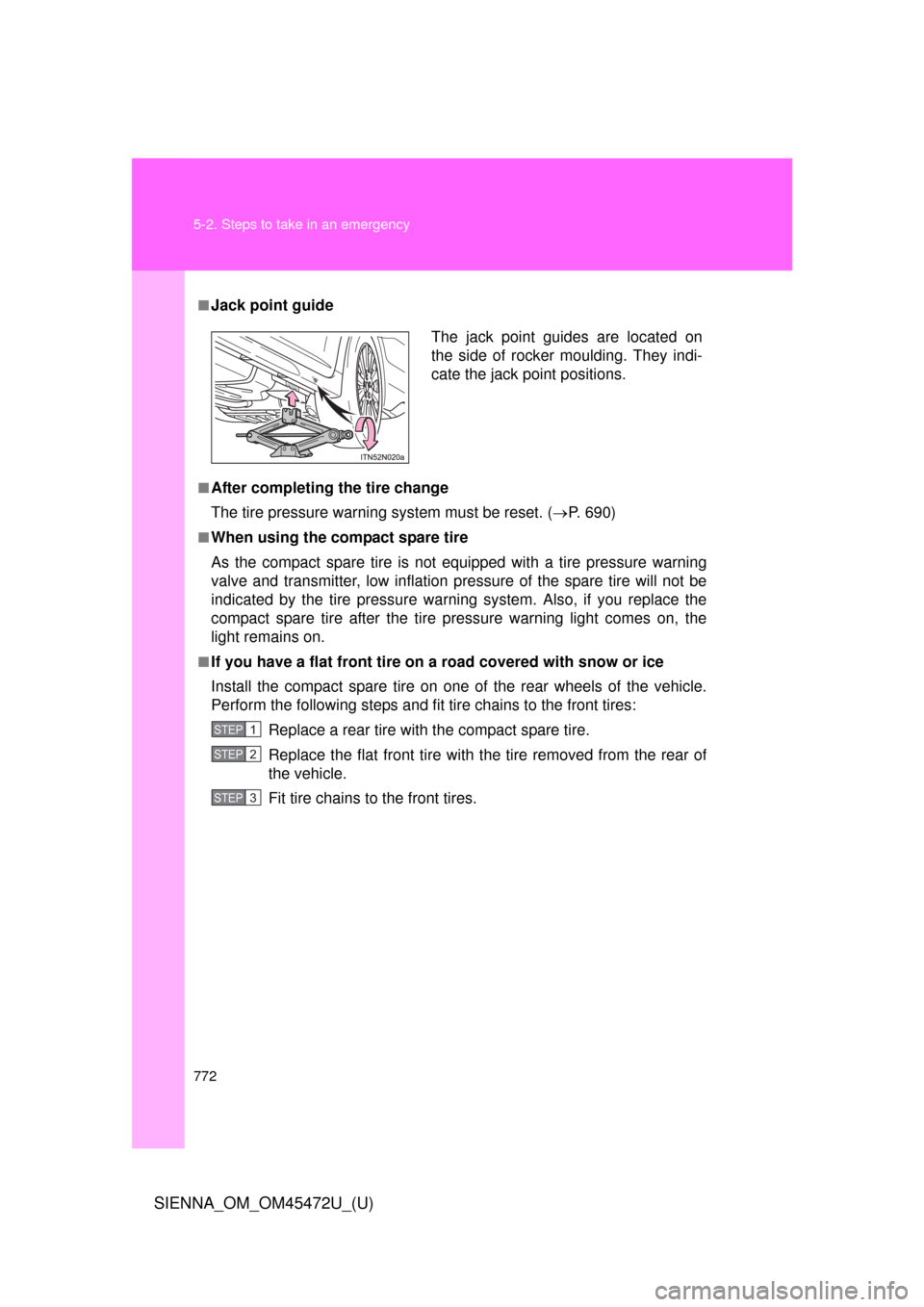Page 759 of 876

5
When trouble arises
759
5-2. Steps to take in an emergency
SIENNA_OM_OM45472U_(U)
CAUTION
Your vehicle has also been equipped with a TPMS (tire pressure warning
system) malfunction indicator to indi
cate when the system is not operat-
ing properly. The TPMS (tire pressure warning system) malfunction indi-
cator is combined with the low tire pressure telltale (tire pressure
warning light). When the system det ects a malfunction, the telltale will
flash for approximately one minute an d then remain continuously illumi-
nated. This sequence will continue upon subsequent vehicle start-ups as
long as the malfunction exists. When the malfunction indi cator is illumi-
nated, the system may not be able to detect or signal low tire pressure
as intended.
TPMS (tire pressure warning system) malfunctions may occur for a vari-
ety of reasons, including the installati on of replacement or alternate tires
or wheels on the vehicle that prevent the TPMS (tire pressure warning
system) from functioning properly. Always check the TPMS (tire pres-
sure warning system) malfunction te lltale after replacing one or more
tires or wheels on your vehicle to ensure that the replacement or alter-
nate tires and wheels allow the TPMS (tire pressure warning system) to
continue to function properly.
NOTICE
■Precaution when installing a different tire
When a tire of a different specification or maker is installed, the tire pres-
sure warning system may not operate properly.
Page 760 of 876
760
5-2. Steps to take in an emergency
SIENNA_OM_OM45472U_(U)
If a warning message is displayed
: If equipped
The multi-information display shows warnings of system malfunc-
tions or incorrectly performed operations. When a message is
shown, perform corrections as indicated in the message.
Master warning light
The master warning light comes on or flashes when a message is
being shown on the multi-information display.
Multi-information display
Warning message
Correction procedure
■ Warning buzzer
A buzzer may sound when a warning message is shown on the
multi-informat ion display.
■ If the warning message is shown again after its correction
procedure has been performed
Contact your Toyota dealer as soon as possible.
Page 761 of 876
5
When trouble arises
761
5-2. Steps to take in an emergency
SIENNA_OM_OM45472U_(U)
If you have a flat tire (vehicles with run-flat tires)
■In some condition (such as at high temperatures)
You cannot continue driving for up to 100 miles (160 km).
■For the detailed information on run-flat tires
See the tire warranty booklet.
You can continue driving a vehicle with run-flat tires even if any
tire goes flat.
In this case, slow down and drive with extra caution.
■Run-flat tires (A “RFT” or “DSST” mark is molded on the
sidewall)
Take your vehicle to the near-
est Toyota dealer or autho-
rized tire dealer as soon as
possible if any tire goes flat.
The vehicle can be driven for
a maximum of 100 miles
(160 km) at a speed below 55
mph (90 km/h) after the tire
pressure warning light comes
on. (P. 749)
Page 762 of 876
762 5-2. Steps to take in an emergency
SIENNA_OM_OM45472U_(U)
NOTICE
■When replacing the tires
When removing or fitting the wheels, tires or the tire pressure warning
valve and transmitter, contact your Toyota dealer as the tire pressure
warning valve and transmitter may be damaged if not handled correctly.
■When driving over bumps
If a vehicle has a flat tire, the ve hicle height will be lower than usual.
Ensure that nothing strikes the bottom of the vehicle.
■To avoid damaging the tire pressure warning valves and transmit-
ters
Do not use liquid sealants on flat tires.
Page 772 of 876

772 5-2. Steps to take in an emergency
SIENNA_OM_OM45472U_(U)
■Jack point guide
■After completing the tire change
The tire pressure warning system must be reset. ( P. 690)
■When using the compact spare tire
As the compact spare tire is not equipped with a tire pressure warning
valve and transmitter, low inflation pressure of the spare tire will not be
indicated by the tire pressure warn ing system. Also, if you replace the
compact spare tire after the tire pressure warning light comes on, the
light remains on.
■If you have a flat front tire on a road covered with snow or ice
Install the compact spare tire on one of the rear wheels of the vehicle.
Perform the following steps and fit tire chains to the front tires:
Replace a rear tire with the compact spare tire.
Replace the flat front tire with the tire removed from the rear of
the vehicle.
Fit tire chains to the front tires.
The jack point guides are located on
the side of rocker moulding. They indi-
cate the jack point positions.
STEP1
STEP2
STEP3
Page 777 of 876

5
When trouble arises
777
5-2. Steps to take in an emergency
SIENNA_OM_OM45472U_(U)
NOTICE
■Driving with tire chains and the compact spare tire
Do not fit tire chains to the compact spare tire.
Tire chains may damage the vehicle body and adversely affect driving
performance.
■When replacing the tires
When removing or fitting the wheels, tires or the tire pressure warning
valve and transmitter, contact your
Toyota dealer as the tire pressure
warning valve and transmitter may be damaged if not handled correctly.
■To avoid damage to the tire pressure warning valves and transmit-
ters
When a tire is repaired with liquid sealants, the tire pressure warning
valve and transmitter may not operate properly. If a liquid sealant is
used, contact your Toyota dealer or other qualified service shop as soon
as possible. Make sure to replace the tire pressure warning valve and
transmitter when replacing the tire. ( P. 690)
■After taking out or stowing the spare tire
Make sure to secure the tire carrier by tightening the clamp bolt to pre-
vent the holding bracket from hitting the under body of the vehicle during
driving.
■Using the tire carrier
●As the tire carrier is designed fo r use with the compact spare tire, it
cannot be used with standard tires.
●If the spare tire is flat, do not use th e tire carrier, as the tire may not be
held securely.
Page 822 of 876

822 6-1. Specifications
SIENNA_OM_OM45472U_(U)■
Treadwear
The treadwear grade is a comparative rating based on the wear
rate of the tire when tested under controlled conditions on a speci-
fied government test course.
For example, a tire graded 150 would wear one and a half (1-1/2)
times as well on the government course as a tire graded 100.
The relative performance of tires depends upon the actual conditions
of their use, performance may differ significantly from the norm due
to variations in driving habits, service practices and differences in
road characteristics and climate.
■ Traction AA, A, B, C
The traction grades, from highest to lowest, are AA, A, B and C,
and they represent the tire’s ab ility to stop on wet pavement as
measured under controlled cond itions on specified government
test surfaces of asphalt and concrete.
A tire marked C may have poor traction performance.
Warning: The traction grade assigned to this tire is based on braking
(straight ahead) traction tests and does not include cornering (turn-
ing) traction.
Page 823 of 876

823
6-1. Specifications
6
Vehicle specifications
SIENNA_OM_OM45472U_(U)
■
Temperature A, B, C
The temperature grades are A (the highest), B, and C, represent-
ing the tire’s resistance to the generation of heat and its ability to
dissipate heat when tested under controlled conditions on a speci-
fied indoor laboratory test wheel.
Sustained high temperature can cause the material of the tire to
degenerate and reduce tire life, and excessive temperature can lead
to sudden tire failure.
The grade C corresponds to a level of performance which all passen-
ger car tires must meet under the Federal Motor Vehicle Safety Stan-
dard No. 109.
Grades B and A represent higher levels of performance on the labo-
ratory test wheel than the minimum required by law.
Warning: The temperature grades of a tire assume that it is properly
inflated and not overloaded.
Excessive speed, underinflation, or excessive loading, either sepa-
rately or in combination, can caus e heat buildup and possible tire fail-
ure.